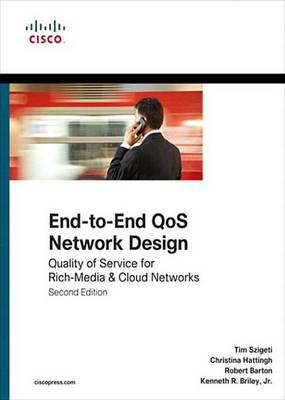Best-practice QoS designs for protecting voice, video, and critical data while mitigating network denial-of-service attacks
Understand the service-level requirements of voice, video, and data applications Examine strategic QoS best practices, including Scavenger-class QoS tactics for DoS/worm mitigation Learn about QoS tools and the various interdependencies and caveats of these tools that can impact design considerations Learn how to protect voice, video, and data traffic using various QoS mechanisms Evaluate design recommendations for protecting voice, video, and multiple classes of data while mitigating DoS/worm attacks for the following network infrastructure architectures: campus LAN, private WAN, MPLS VPN, and IPSec VPNQuality of Service (QoS) has already proven itself as the enabling technology for the convergence of voice, video, and data networks. As business needs evolve, so do the demands for QoS. The need to protect critical applications via QoS mechanisms in business networks has escalated over the past few years, primarily due to the increased frequency and sophistication of denial-of-service (DoS) and worm attacks.
End-to-End QoS Network Design is a detailed handbook for planning and deploying QoS solutions to address current business needs. This book goes beyond discussing available QoS technologies and considers detailed design examples that illustrate where, when, and how to deploy various QoS features to provide validated and tested solutions for voice, video, and critical data over the LAN, WAN, and VPN.
The book starts with a brief background of network infrastructure evolution and the subsequent need for QoS. It then goes on to cover the various QoS features and tools currently available and comments on their evolution and direction. The QoS requirements of voice, interactive and streaming video, and multiple classes of data applications are presented, along with an overview of the nature and effects of various types of DoS and worm attacks. QoS best-practice design principles are introduced to show how QoS mechanisms can be strategically deployed end-to-end to address application requirements while mitigating network attacks. The next section focuses on how these strategic design principles are applied to campus LAN QoS design. Considerations and detailed design recommendations specific to the access, distribution, and core layers of an enterprise campus network are presented. Private WAN QoS design is discussed in the following section, where WAN-specific considerations and detailed QoS designs are presented for leased-lines, Frame Relay, ATM, ATM-to-FR Service Interworking, and ISDN networks. Branch-specific designs include Cisco (R) SAFE recommendations for using Network-Based Application Recognition (NBAR) for known-worm identification and policing. The final section covers Layer 3 VPN QoS design-for both MPLS and IPSec VPNs. As businesses are migrating to VPNs to meet their wide-area networking needs at lower costs, considerations specific to these topologies are required to be reflected in their customer-edge QoS designs. MPLS VPN QoS design is examined from both the enterprise and service provider's perspectives. Additionally, IPSec VPN QoS designs cover site-to-site and teleworker contexts.
Whether you are looking for an introduction to QoS principles and practices or a QoS planning and deployment guide, this book provides you with the expert advice you need to design and implement comprehensive QoS solutions.
- ISBN10 0133116077
- ISBN13 9780133116076
- Publish Date 12 November 2013 (first published 9 November 2004)
- Publish Status Active
- Imprint Cisco Press
- Format eBook
- Pages 1090
- Language English
